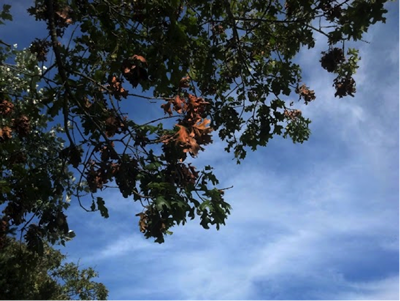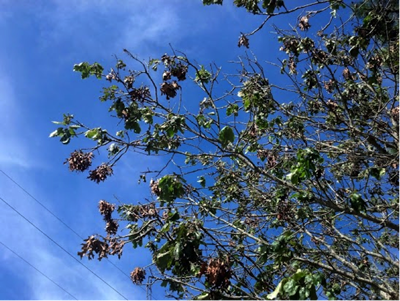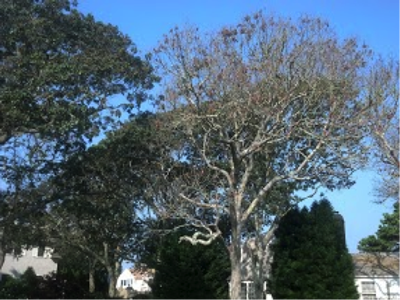CapeWomenOnline - Where Cape Women Shine
Your local venue for the women of Cape Cod to share their ideas, experiences and resources while inspiring each other in their life's journey
Inspire . Encourage . Network . Share
What's Happening To Our Environment? is a new column that explores issues that in our humble opinion are not getting enough press time. This is also a column for you to share your environmental concerns about issues that may not have a simple solution. By discussing them here, we hope to raise awareness of these issues and nudge those who CAN find answers into action.
In the first of this new series, we look at damage Cape Cod's oak trees have suffered after being infested by Crypt Gall Wasps.
Email your environmental concerns to Nicola@CapeWomenonline.com
What's Happening To Our Environment?
Cape Cod Without Oak Trees? Seriously?
by Nicola Burnell
To quote the inimitable British musician Joe Jackson:
"Cause if my eyes don't deceive me there's something going wrong around here."
In the Summer issue of CapeWomenOnline magazine, I asked readers to "look up" and examine the canopies of the oak trees in their neighborhood. The signs are so obvious they are hard to miss, but several months later, people are STILL unaware of this environmental nightmare playing out right in our own back yards!
Many of our red and black oak trees are suffering from a parasite called Crypt Gall Wasp, which is literally sucking the life out of them. If we continue to ignore this problem we may be looking at a future Cape Cod without oak trees. This would be a disaster, not just because our oaks are beautiful trees, but because they protect our little peninsula during very high winds by absorbing the extreme gusts with an almost synchronized dance of their canopies.
Crypt Gall Wasps are destroying oak trees all across the Cape from within their own vascular system by injecting their eggs into the trees' limbs. In return for this unwelcome gift, the trees then protect these eggs by building "galls" around them and feeding them their own nutrients all winter long.
Unlike Winter Moths, which can be controlled by spraying trees in early Spring, before the leaves emerge, Crypt Gall Wasps are so new to Cape Cod that arborists (and local government) are still learning about the life cycle of this tiny creature and are scratching their heads about how to stop it from decimating our trees.
Arborists are currently testing various insecticides, followed by heavy fertilization in the Fall, but everyone I've talked to tells me "there are no guarantees" that this treatment will even work. In fact, several tree experts told me to hold off on treating my trees because it is costly and it's probably too late to save them anyway. Sad news for a certified tree hugger.
My house is surrounded by tall oak trees. I've watched their nimble canopies swirl and bend under the sudden gusts of hurricane force winds. But many of my oaks are now very sick and I'm trying to imagine my land without them. I can't, so through this new column, I hope to find a way to stop this oak death before it's too late.

infestation of Crypt Gall Wasp
I first saw the telltale cluster of brown leaves last year in the oak trees right outside my bedroom window. I routinely have my trees sprayed for Winter Moth, so I assumed they were just leaves that had not fallen off the branches the previous year. I know, the trees had been bare all winter, but bear with me (pun intended). Bottom line is this: I ignored something that caused me to pause and question the health of my trees…big mistake!
By the time you see the dead leaf clusters in your oaks, it's too late to save your trees – the damage has already taken hold of the trees' delicate vascular system.
In the Spring, oak trees show their first signs of infestation with branches that fail to produce leaves, or leaves that are either very small or begin to brown around the edges soon after they uncurl. Other signs include broken branches that easily snap off the tree and contain gnarly bumps and tiny pin-holes where the emerging wasps have eaten their way out of their cocoon. Break open an infested branch, and you might see small, shiny, black eggs!

My trees (and many other trees in my neighborhood) are now in their second year of visible Gall Wasp infestation. Their upper canopies are missing leaves, and the lower canopies have gnarled branches with dead leaf clusters clinging to their tips.
Perhaps one of the most heartbreaking facts about this issue is that the trees know they're sick. They try to fight the Gall Wasp infestation by sending out more shoots up their trunks. At first, I was hopeful that these new branches and leaves could survive, but my hopes were dashed when I saw them also wither and die within weeks of emerging.

When I walk through my neighborhood or drive across the Cape, I can't help but rant about the extent of this disaster. I talk to anyone who will listen to me in the hopes that SOMEONE has an answer, but residents seem as frustrated and upset about this as I am. There must be something we can do – if you know of any solutions please email me – I'm all ears!
As I write this, I'm listening to birds, squirrels and chipmunks chase each other in the tree canopies above my deck, and my heart aches to think they might not have these trees to nest in next year. I know what my trees will soon look like from the other trees in my neighborhood that have already died, like the one in the photograph below, taken across the street from my home in August.

trees that must be taken down
The first step towards finding a resolution is in first asking the question. Can you help?
For more details about this problem Click HERE to read a fact sheet published by the Cape Cod Cooperative Extension Service.

Nicola Burnell is the Publisher, Editor and a contributing writer for this magazine. In addition to writing her own novels, she teaches a series of Writing, Creativity Development and Personal Growth Classes.
She also works as a freelance editor and a Booktrope Publishing Book Manager.
Nicola is a member in Letters of the National League of American Pen Women and is Historian of the Cape Cod Branch. She strives to support the Arts on Cape Cod and collaborates with several cultural organizations in her community.
Nicola facilitates a variety of fun and inspiring CWO Events and launched the first annual Cranberry Creativity Conference September 27-29, 2013. This conference brings artists, writers and musicians together in a series of classes and workshops that culminates in a closing afternoon festival of the work produced in each class.
Nicola lives in Harwich with her two sons and several pets.
To contact Nicola email Nicola@CapeWomenOnline.com
You can also follow her on Twitter and read her blog: "Nic's Novel Project"


